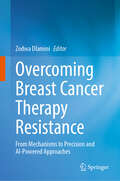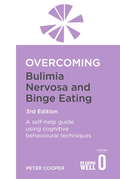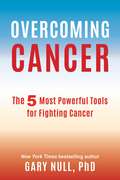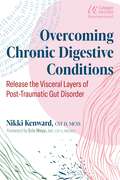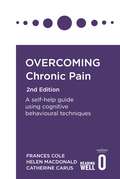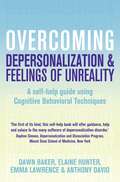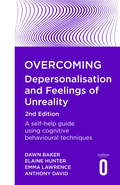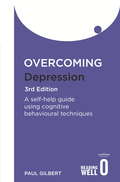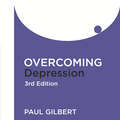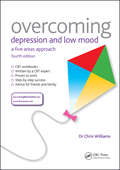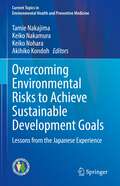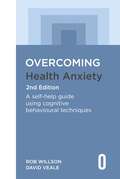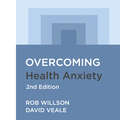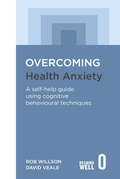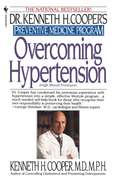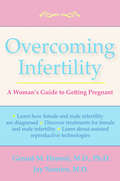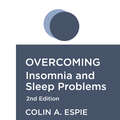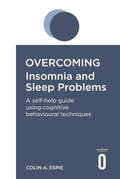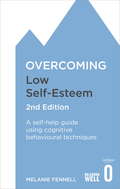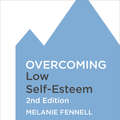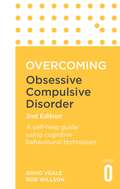- Table View
- List View
Overcoming Breast Cancer Therapy Resistance: From Mechanisms to Precision and AI-Powered Approaches
by Zodwa DlaminiThis book addresses the pressing problem of drug resistance in the treatment of breast cancer. It provides a comprehensive understanding of the complex mechanisms underlying drug resistance and presents the latest advances in therapeutic approaches to overcome this enormous challenge. The book begins with an introduction to the biology of breast cancer, treatment modalities and the mechanisms of drug resistance. This includes the principles of drug resistance in targeted, immune-, endocrine and chemotherapy. In the following sections, the authors present innovative strategies to overcome drug resistance and new research directions, among others the role of the microbiome in drug resistance, molecular profiling of patients for personalized medical care, and new drug delivery systems. Finally, the book concludes with a discussion of the differences in the prevalence and treatment success of breast cancer between high- and low-income countries. This book is an informative resource for students, researchers, and clinicians in the field of breast cancer research and oncology in general.
Overcoming Bulimia Nervosa and Binge Eating 3rd Edition: A self-help guide using cognitive behavioural techniques
by Prof Peter CooperAs many as one in 20 women in the western world suffer bouts of uncontrolled binge-eating. Going without food for long periods, making yourself vomit and taking laxatives you don't need are also common and are symptoms of bulimia nervosa. Such illness costs lives if not successfully treated.Now in its second edition, Peter Cooper's sympathetic and highly acclaimed guide gives a clear explanation of the disorder and the serious health issues that can result from it. He describes the treatments available today and, most importantly, sets out a self-help guide for those who want to tackle their difficulties for themselves, with a step-by-step programme. This is a real chance for sufferers to take the road to recovery, and will give their friends and family a much clearer understanding of the illness and its remedy.
Overcoming Cancer: The 5 Most Powerful Tools for Fighting Cancer
by Gary NullOne word strikes more fear into a person’s mind than any other: cancer. The physical, mental, emotional, and financial toll that comes with a cancer diagnosis is immense and affects not only cancer patients but also families and entire communities. The vast majority of individuals who lose the battle against cancer are treated with the standard orthodox therapy. These people may never have questioned their oncologists, believing that they were in the best possible hands with their physicians’ advanced education, their knowledge of the latest treatments, and all the tools of modern research at their disposals.In Overcoming Cancer, Gary Null explores the alternative treatments that most mainstream doctors will never discuss with their patients. Did you know that eating melons balances your body’s pH, which can help slow the growth of cancer? You were aware that fiber is an important part of a healthy diet, but did you know that it lowers the risk of breast, colorectal, uterine, and prostate cancers? Find health and vitality with Dr. Null’s five most powerful tools for fighting cancer.
Overcoming Chronic Digestive Conditions: Release the Visceral Layers of Post-Traumatic Gut Disorder
by Nikki KenwardA holistic approach for healing trauma stored in the gut• Explains how and why emotions and trauma are stored in the gut, causing digestive issues and visceral tensions • Presents recent research that enriches our understanding of the gut as a center of emotional and spiritual growth • Shares a hands-on process of listening to the gut layer by layer to help heal gut issues, renew the microbiome, and release intergenerational trauma A healthy gut is fundamental to a healthy life. Embedded within our digestive system is the enteric nervous system, our &“second brain,&” which serves to protect us from the external world of adversity, including not only viruses and bacteria, but also traumatic events. As Nikki Kenward, CST-D, MCSS, explains, past challenges and traumas, whether emotional or physical, are held in the enteric nervous system in many ways, including fascial tension, cellular changes, and unhelpful &“default settings.&” Exploring in depth what she calls &“the Post-Traumatic Gut,&” Kenward describes the anatomy and physiology of the enteric nervous system, including the polyvagal system, and the many ways that our emotional history and current emotional state can impact our digestive system. Sharing recent research, she describes the science behind the emotional gut and how to apply it to chronic digestive issues like IBS and Crohn&’s disease as well as mental health issues such as anorexia, bulimia, anxiety, and depression. She explains how and why the digestive gut absorbs emotions and what you can do to heal its functions by addressing psychosomatic stressors, rather than just nutrition. Presenting case studies from her 25 years in clinical practice as well as her own healing journey, she reveals the synchronicity between digestive/metabolic functions and psychological/perceptual insight and how allowing the cells to &“speak&” through bodywork such as CranioSacral Therapy and SomatoEmotional Release Therapy can help renew the microbiome of the second brain, release intergenerational trauma and illness, and restore one&’s psychospiritual life. Sharing visualization exercises and a hands-on process of listening to the gut layer by layer, the author helps readers unwind stagnant cellular patterns, discover the dynamic intelligence in every cell, and transform Post-Traumatic Gut into Post-Traumatic growth.
Overcoming Chronic Pain 2nd Edition: A self-help guide using cognitive behavioural techniques
by Helen Macdonald Frances Cole Catherine CarusTake control of your life, take control of your painChronic pain can be extremely debilitating; however, it does not need to dominate your life. This self-help book is based on highly effective self-help methods developed by specialists and used in community and hospital pain management programmes. Your experience of pain can be greatly reduced by pacing daily activities, reducing stress, learning relaxation techniques and effective ways to cope with depression, anxiety, worry, anger and frustration.This easy-to-follow book sets out:- Why pain can persist when there's no injury or disease present- How to become fitter and pace your activities- Practical ways to improve sleep and relaxation- Tips for returning to work, study and gaining a life you valueOvercoming self-help guides use clinically proven techniques to treat long-standing and disabling conditions, both psychological and physical.This book is recommended by the national Reading Well scheme for England delivered by The Reading Agency and the Society of Chief Librarians with funding from Arts Council England and Wellcome.
Overcoming Chronic Pain 2nd Edition: A self-help guide using cognitive behavioural techniques (Overcoming Books)
by Helen Macdonald Catherine Carus Dr. Frances ColeTake control of your life, take control of your painChronic pain can be extremely debilitating; however, it does not need to dominate your life. This self-help book is based on highly effective self-help methods developed by specialists and used in community and hospital pain management programmes. Your experience of pain can be greatly reduced by pacing daily activities, reducing stress, learning relaxation techniques and effective ways to cope with depression, anxiety, worry, anger and frustration.This easy-to-follow book sets out:- Why pain can persist when there's no injury or disease present- How to become fitter and pace your activities- Practical ways to improve sleep and relaxation- Tips for returning to work, study and gaining a life you valueOvercoming self-help guides use clinically proven techniques to treat long-standing and disabling conditions, both psychological and physical.This book is recommended by the national Reading Well scheme for England delivered by The Reading Agency and the Society of Chief Librarians with funding from Arts Council England and Wellcome.
Overcoming Depersonalisation and Feelings of Unreality, 2nd Edition: A self-help guide using cognitive behavioural techniques
by Anthony David Emma Lawrence Dawn BakerDepersonalization Disorder is when a person experiences a feeling of being detached from life around them and sometimes emotionally numb. It is often a symptom of another disorder such as anxiety, depression, posttraumatic stress disorder and particularly panic disorder, or of an illness like epilepsy or migraine, but also occurs in its own right and among users of certain drugs. CBT is an effective treatment.PRAISE FOR THE SERIES: 'The best consumer-friendly CBT-based books&All are very thorough.' Observer 'The Overcoming series just keeps getting better and better.' The Psychologist
Overcoming Depersonalisation and Feelings of Unreality, 2nd Edition: A self-help guide using cognitive behavioural techniques
by Anthony David Emma Lawrence Dawn Baker Elaine Hunter'The first of its kind, this self-help book will offer guidance, help and solace to the many sufferers of depersonalization disorder.'Daphne Simeon, Depersonalisation and Dissociation Program, Mount Sinai School of Medicine, New YorkDepersonalization disorder can make you feel detached from life and many people describe feeling 'emotionally numb', unreal or even as if their body doesn't belong to them. It can be a symptom of another problem such as anxiety, depression, post-traumatic stress disorder and, particularly, of panic disorder, or of an illness like epilepsy or migraine. It can also occur in its own right and/or as a side effect of certain drugs.This self-help book, written by leading experts, will help you to understand what causes depersonalization disorder and what can keep it going, and will introduce you to effective strategies to overcome it:Based on clinically proven cognitive behavioural therapy (CBT) techniques Clear and accessible step-by-step exercises and tools, including diary-keeping and problem-solving Overcoming self-help guides use clinically proven techniques to treat long-standing and disabling conditions, both psychological and physical. Many guides in the Overcoming series are recommended under the Reading Well Books on Prescription scheme.Series Editor: Professor Peter Cooper
Overcoming Depersonalisation and Feelings of Unreality: A self-help guide using cognitive behavioural techniques (Overcoming Ser.)
by Anthony David Emma Lawrence Dawn Baker'The first of its kind, this self-help book will offer guidance, help and solace to the many sufferers of depersonalization disorder.'Daphne Simeon, Depersonalisation and Dissociation Program, Mount Sinai School of Medicine, New YorkDepersonalization disorder can make you feel detached from life and many people describe feeling 'emotionally numb', unreal or even as if their body doesn't belong to them. It can be a symptom of another problem such as anxiety, depression, post-traumatic stress disorder and, particularly, of panic disorder, or of an illness like epilepsy or migraine. It can also occur in its own right and/or as a side effect of certain drugs.This self-help book, written by leading experts, will help you to understand what causes depersonalization disorder and what can keep it going, and will introduce you to effective strategies to overcome it:Based on clinically proven cognitive behavioural therapy (CBT) techniques Clear and accessible step-by-step exercises and tools, including diary-keeping and problem-solving Overcoming self-help guides use clinically proven techniques to treat long-standing and disabling conditions, both psychological and physical. Many guides in the Overcoming series are recommended under the Reading Well Books on Prescription scheme.Series Editor: Professor Peter Cooper
Overcoming Depression 3rd Edition: A self-help guide using cognitive behavioural techniques
by Paul GilbertOvercoming app now available via iTunes and the Google Play Store.A Books on Prescription TitleBreak free from the hell of depressionIf you suffer from depression you are far from alone. Depression is very common, affecting over 300 million people around the world. Written by Professor Paul Gilbert, internationally recognised for his work on depression, this highly acclaimed self-help book has been of benefit to thousands of people including sufferers, their friends and families, and those working in the medical profession.This fully revised third edition has been extensively updated and rewritten to reflect over ten years of new research on understanding and treating depression, particularly the importance of developing compassionate ways of thinking, behaving and feeling. It contains helpful case studies and new, easy-to-follow, step-by-step suggestions and exercises to help you understand your depression and lift your mood.
Overcoming Depression 3rd Edition: A self-help guide using cognitive behavioural techniques (Overcoming Books)
by Prof Paul GilbertOvercoming app now available via iTunes and the Google Play Store.A Books on Prescription TitleBreak free from the hell of depressionIf you suffer from depression you are far from alone. Depression is very common, affecting over 300 million people around the world. Written by Professor Paul Gilbert, internationally recognised for his work on depression, this highly acclaimed self-help book has been of benefit to thousands of people including sufferers, their friends and families, and those working in the medical profession.This fully revised third edition has been extensively updated and rewritten to reflect over ten years of new research on understanding and treating depression, particularly the importance of developing compassionate ways of thinking, behaving and feeling. It contains helpful case studies and new, easy-to-follow, step-by-step suggestions and exercises to help you understand your depression and lift your mood.
Overcoming Depression 3rd Edition: A self-help guide using cognitive behavioural techniques (Overcoming Childhood Trauma Ser.)
by Prof Paul GilbertOvercoming app now available via iTunes and the Google Play Store.A Books on Prescription TitleBreak free from the hell of depressionIf you suffer from depression you are far from alone. Depression is very common, affecting over 300 million people around the world. Written by Professor Paul Gilbert, internationally recognised for his work on depression, this highly acclaimed self-help book has been of benefit to thousands of people including sufferers, their friends and families, and those working in the medical profession.This fully revised third edition has been extensively updated and rewritten to reflect over ten years of new research on understanding and treating depression, particularly the importance of developing compassionate ways of thinking, behaving and feeling. It contains helpful case studies and new, easy-to-follow, step-by-step suggestions and exercises to help you understand your depression and lift your mood.
Overcoming Depression and Low Mood: A Five Areas Approach, Fourth Edition (Overcoming)
by Chris WilliamsDepression affects many people at some point in their lives. Fortunately, we now know that by changing certain thoughts and behaviour patterns you can greatly improve how you feel. Overcoming Depression and Low Mood: A Five Areas Approach explains how low mood can affect your life. It helps you understand why you sometimes feel low, anxious, angry, or guilty. It also teaches proven practical skills to help you change how you feel. By using the clearly described practical tools inside, you can make helpful changes to your life. Ultimately, the hope is that this book will help you to regain a sense of control over how you feel.The book is based on a cognitive behavioural therapy approach. The developers of this approach found many effective ways of tackling common symptoms and problems people face when feeling low. The course can make a big difference if you can commit to using it. Having someone else to encourage you is also important. Interactive questions and worksheets, which are a key feature of the series, are plentiful in this new edition. An award-winning companion website, www.livinglifetothefull.com, includes additional support materials and information.
Overcoming Environmental Risks to Achieve Sustainable Development Goals: Lessons from the Japanese Experience (Current Topics in Environmental Health and Preventive Medicine)
by Keiko Nakamura Tamie Nakajima Keiko Nohara Akihiko KondohThis thought-provoking book examines how the accumulated knowledge on past and present environmental issues and risks within Japan can be applied in order to help deliver the transformation to a sustainable and well-being society. The book opens with a series of case analyses on environmental pollution events and pollution-related diseases within the country over the past half century or more. Lessons learned regarding the harm to society are highlighted. Diverse current environmental issues are then explored in detail, ranging from the management of hazardous chemical and asbestos exposure to marine plastic pollution and nuclear disasters. This discussion forms the basis for the final part of the book, which focuses on how progress can be made towards the Sustainable Development Goals set out in the United Nations’ 2030 Agenda for Sustainable Development. Important insights are also provided into future directions in human ecology and ecotoxicology. The book will be a valuable resource for both new and established researchers as well as for those seeking comprehensive information on environmental/occupational health and health promotion.
Overcoming Health Anxiety 2nd Edition: A self-help guide using cognitive behavioural techniques (Overcoming Books)
by Rob Willson David VealeHow you can stop worrying about your health and enjoy life'This book not only helps sufferers to better understand the nature of the problem, but also provides them with the skills necessary to overcome it and to regain quality of life'Professor Paul Salkovskis, Professor of Experimental Psychology, University of OxfordMany of us have a tendency to worry unnecessarily about our health. For some the anxiety becomes severe and persistent. This can involve spending many hours checking for symptoms, seeking reassurance from others, surfing the internet for information about different diseases, or repeatedly visiting the doctor. It is distressing for them and for everyone around them.In fact, health anxiety can be very successfully treated with cognitive behavioural therapy (CBT) - the approach taken in this self-help guide. Using a structured, step-by-step approach the authors explain how the problem develops, how to recognise what feeds it and how to develop effective methods of dealing with it. This book includes:- Questionnaires, case studies and exercises- Chapters on fear of death and on medicationOvercoming self-help guides use clinically proven techniques to treat long-standing and disabling conditions, boith psychological and physical.READING WELLThis book is recommended by the national Reading Well scheme for England and Wales delivered by The Reading Agency and the Society of Chief Librarians with funding from Arts Council England and Wellcome.www.reading-well.org.ukSeries Editor: Emeritus Professor Peter Cooper
Overcoming Health Anxiety 2nd Edition: A self-help guide using cognitive behavioural techniques (Overcoming Books)
by Rob Willson David VealeHow you can stop worrying about your health and enjoy life'This book not only helps sufferers to better understand the nature of the problem, but also provides them with the skills necessary to overcome it and to regain quality of life'Professor Paul Salkovskis, Professor of Experimental Psychology, University of OxfordMany of us have a tendency to worry unnecessarily about our health. For some the anxiety becomes severe and persistent. This can involve spending many hours checking for symptoms, seeking reassurance from others, surfing the internet for information about different diseases, or repeatedly visiting the doctor. It is distressing for them and for everyone around them.In fact, health anxiety can be very successfully treated with cognitive behavioural therapy (CBT) - the approach taken in this self-help guide. Using a structured, step-by-step approach the authors explain how the problem develops, how to recognise what feeds it and how to develop effective methods of dealing with it. This book includes:- Questionnaires, case studies and exercises- Chapters on fear of death and on medicationOvercoming self-help guides use clinically proven techniques to treat long-standing and disabling conditions, boith psychological and physical.READING WELLThis book is recommended by the national Reading Well scheme for England and Wales delivered by The Reading Agency and the Society of Chief Librarians with funding from Arts Council England and Wellcome.www.reading-well.org.ukSeries Editor: Emeritus Professor Peter Cooper
Overcoming Health Anxiety 2nd Edition: A self-help guide using cognitive behavioural techniques (Overcoming Books)
by Rob Willson David VealeHow you can stop worrying about your health and enjoy life'This book not only helps sufferers to better understand the nature of the problem, but also provides them with the skills necessary to overcome it and to regain quality of life'Professor Paul Salkovskis, Professor of Experimental Psychology, University of OxfordMany of us have a tendency to worry unnecessarily about our health. For some the anxiety becomes severe and persistent. This can involve spending many hours checking for symptoms, seeking reassurance from others, surfing the internet for information about different diseases, or repeatedly visiting the doctor. It is distressing for them and for everyone around them.In fact, health anxiety can be very successfully treated with cognitive behavioural therapy (CBT) - the approach taken in this self-help guide. Using a structured, step-by-step approach the authors explain how the problem develops, how to recognise what feeds it and how to develop effective methods of dealing with it. This book includes:- Questionnaires, case studies and exercises- Chapters on fear of death and on medicationOvercoming self-help guides use clinically proven techniques to treat long-standing and disabling conditions, boith psychological and physical.READING WELLThis book is recommended by the national Reading Well scheme for England and Wales delivered by The Reading Agency and the Society of Chief Librarians with funding from Arts Council England and Wellcome.www.reading-well.org.ukSeries Editor: Emeritus Professor Peter Cooper
Overcoming Health Anxiety: A self-help guide using cognitive behavioural techniques
by Rob Willson David VealeStop worrying about your health and enjoy life.Many of us have a tendency to worry unnecessarily about our health. This can be worse in a time of global panic about pandemics. For some, the anxiety becomes chronic, and they may spend many hours checking for symptoms, seeking reassurance from others, surfing the internet for information about different diseases, or repeatedly visiting the doctor. It is distressing for them and for everyone around them.In fact, health anxiety can be very successfully treated with cognitive behavioural therapy - the approach taken in this self-help guide. Using a structured, step-by-step approach, the authors explain how the problem develops, how to recognise what feeds it and how to develop effective methods of dealing with it.- Includes questionnaires, case studies and exercises- Based on proven CBT techniques- Includes a chapter on fear of death and fear of vomiting
Overcoming Hypertension: Preventive Medicine Program (Dr. Kenneth H. Cooper's Preventive Medicine Program)
by Kenneth H. CooperLike a time bomb ticking away, hypertension builds quietly, gradually, placing unbearable strain on the body until it explodes--in heart attack, stroke, kidney failure, arterial disease, even death. But the disease does not have to progress that way. Here, in the third volume of the highly acclaimed Preventive Medicine Program, Dr. Kenneth H. Cooper, one of the nations foremost experts in the field of preventive medicine, presents a medically sound, reassuringly simple program that help you lower you blood pressure--and keep it down, often without drugs. Overcoming Hypertension gives you:--The latest facts on how cholesterol, cigarette smoking, obesity, and stress affect coronary risk levels.--Your high blood pressure risk profile, with newly devised charts for men and women.--A complete fitness program that lets you choose the sport that works for you. Plus a unique illustrated guide to aqua-aerobics.--Tips on talking to your doctor that will help you become an active participant in your own recovery.--A guide to anti-hypertensive drugs--the most up-to-date list of medications, their recommended daily doses, and ways to minimize side effects.--Three distinct dietary programs, complete with menus, recipes, nutritional charts, healthy cooking tips, and much more.--Take charge of your health and well-being with Overcoming Hypertension.From the Paperback edition.
Overcoming Infertility: A Woman's Guide to Getting Pregnant
by Gerard M Honoré Jay NemiroConfronting a problem that affects one out of 10 American couples, this all-inclusive, question-and-answer guide offers insight and encouragement in the face of infertility. Addressing the deep disappointment and emotional distress that accompany a diagnosis, this resource emphasizes that there is still hope regarding this daunting condition. Penned by a reputable endocrinologist who has treated thousands of couples, this helpful reference provides a way to navigate through a confusing time, clearly illustrating the most suitable treatment options. Topics covered include the causes of both female and male infertility, how to cope emotionally with a diagnosis, and utilizing the new Assisted Reproductive Technologies (ART). From choosing a fertility specialist to taking advantage of the most recent developments, this exhaustive study provides practical guidance for couples facing this overwhelming syndrome.
Overcoming Insomnia 2nd Edition: A self-help guide using cognitive behavioural techniques (Overcoming Books)
by Colin EspieA Books on Prescription TitleAll the help you need to conquer your sleep problems and start living life to the fullPoor sleep is one of the most common health problems and can leave you feeling exhausted, stressed and run-down. While prescribed medications and over-the-counter remedies rarely offer lasting benefits, Cognitive Behavioural Therapy can help enormously and is the treatment of choice for insomnia.Develop good pre-bedtime routines.The most effective relaxation techniques.Establish a new sleeping and waking pattern.Deal with a racing mind.Use sleeping pills more effectively.Handle jet lag and sleepwalking.
Overcoming Insomnia and Sleep Problems: A self-help guide using cognitive behavioural techniques (Overcoming Books)
by Colin EspieA Books on Prescription TitleAll the help you need to conquer your sleep problems and start living life to the fullPoor sleep is one of the most common health problems and can leave you feeling exhausted, stressed and run-down. While prescribed medications and over-the-counter remedies rarely offer lasting benefits, Cognitive Behavioural Therapy can help enormously and is the treatment of choice for insomnia.Develop good pre-bedtime routines.The most effective relaxation techniques.Establish a new sleeping and waking pattern.Deal with a racing mind.Use sleeping pills more effectively.Handle jet lag and sleepwalking.
Overcoming Low Self-Esteem, 2nd Edition: A self-help guide using cognitive behavioural techniques
by Dr Melanie FennellOvercoming app now available via iTunes and the Google Play Store.'A thoroughly enjoyable read, and [I] would recommend trainee therapists read it also, as it will increase your understanding of the treatment of low self-esteem.' BABCP MagazineLow self-esteem can make life difficult in all sorts of ways. It can make you anxious and unhappy, tormented by doubts and self-critical thoughts. It can get in the way of feeling at ease with other people and stop you from leading the life you want to lead. It makes it hard to value and appreciate yourself in the same way you would another person you care about. Melanie Fennell's acclaimed and bestselling self-help guide will help you to understand your low self-esteem and break out of the vicious circle of distress, unhelpful behaviour and self-destructive thinking. Using practical techniques from Cognitive Behavioural Therapy (CBT), this book will help you learn the art of self-acceptance and so transform your sense of yourself for the better.Specifically, you will learn: How low self-esteem develops and what keeps it going How to question your negative thoughts and the attitudes that underlie them How to identify your strengths and good qualities for a more balanced, kindly view of yourselfOvercoming self-help guides use clinically proven techniques to treat long-standing and disabling conditions, both psychological and physical. Many guides in the Overcoming series are recommended under the Reading Well Books on Prescription scheme.
Overcoming Low Self-Esteem, 2nd Edition: A self-help guide using cognitive behavioural techniques (Overcoming Books)
by Dr Melanie FennellOvercoming app now available via iTunes and the Google Play Store.'A thoroughly enjoyable read, and [I] would recommend trainee therapists read it also, as it will increase your understanding of the treatment of low self-esteem.' BABCP MagazineLow self-esteem can make life difficult in all sorts of ways. It can make you anxious and unhappy, tormented by doubts and self-critical thoughts. It can get in the way of feeling at ease with other people and stop you from leading the life you want to lead. It makes it hard to value and appreciate yourself in the same way you would another person you care about. Melanie Fennell's acclaimed and bestselling self-help guide will help you to understand your low self-esteem and break out of the vicious circle of distress, unhelpful behaviour and self-destructive thinking. Using practical techniques from Cognitive Behavioural Therapy (CBT), this book will help you learn the art of self-acceptance and so transform your sense of yourself for the better.Specifically, you will learn: How low self-esteem develops and what keeps it going How to question your negative thoughts and the attitudes that underlie them How to identify your strengths and good qualities for a more balanced, kindly view of yourselfOvercoming self-help guides use clinically proven techniques to treat long-standing and disabling conditions, both psychological and physical. Many guides in the Overcoming series are recommended under the Reading Well Books on Prescription scheme.
Overcoming Obsessive Compulsive Disorder, 2nd Edition: A self-help guide using cognitive behavioural techniques
by Rob Willson David VealeBreak free from unhelpful rituals and take control of your life 'Clear, practical, focused and useful... extremely helpful both for those who suffer from obsessive compulsive disorder and those who care for them'Paul Salkovkis, University of BathAre you plagued by a recurring thought or idea that just won't go away, or feel the need to wash your hands repeatedly, to hoard things, or to repeatedly check all appliances in the house have been turned off before you leave? These are common symptoms of obsessive compulsive disorder (OCD), a condition that causes distress to hundreds of thousands of people.Using methods based on real clinical practice and proven cognitive behavioural therapy (CBT) techniques, this revised and updated edition teaches you:· How to face fears and avoided situations· How to control disturbing thoughts, images and urges· Strategies to break free from the destructive cycle of obsessive behaviourOvercoming self-help guides use clinically proven techniques to treat long-standing and disabling conditions, both psychological and physical. READING WELL This book is recommended by the national Reading Well Books on Prescription scheme for England delivered by The Reading Agency and the Society of Chief Librarians with funding from Arts Council England and Wellcome.www.reading-well.org.ukSeries editor: Professor Peter Cooper
